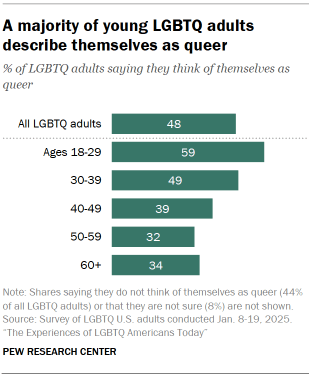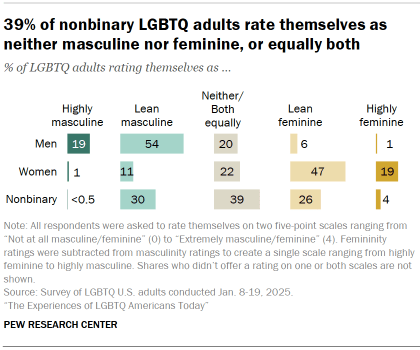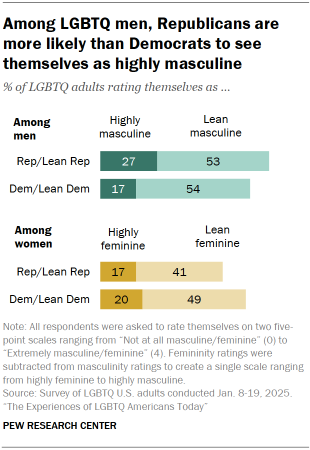To better understand how LGBTQ adults identify, we asked respondents three separate questions:
- If they are gay or lesbian, bisexual, straight or something else
- If they are transgender
- If they think of themselves as queer
When it comes to sexual orientation, more than half of LGBTQ adults (55%) describe themselves as bisexual. Four-in-ten are gay or lesbian, while small shares are straight (1%) or something else (3%).
About one-in-ten LGBTQ adults (9%) are transgender. This includes 4% who are nonbinary, 3% who are men, 1% who are women and 1% who describe their gender in some other way.

About half of all LGBTQ adults (48%) think of themselves as queer, while 44% do not (8% are not sure). Younger LGBTQ adults are particularly likely to identify as queer: 59% of those ages 18 to 29 think of themselves this way, compared with about half of those in their 30s and fewer than half in older age groups.
Answers to these questions reveal that LGBTQ identities often overlap. For example, 80% of transgender adults are gay, lesbian or bisexual. And 82% of trans adults also think of themselves as queer.
For the remainder of this chapter, references to gay, lesbian and bisexual adults exclude those who are transgender. Transgender adults are of any sexual orientation. Queer adults are included in the total and in the gay or lesbian, bisexual, and trans totals if they indicated they also identify with these terms. The number of queer respondents who do not identify as gay or lesbian, bisexual, or trans is too small to analyze separately.
Importance of being LGBTQ to overall identity
About four-in-ten LGBTQ adults (42%) say being gay, lesbian, bisexual, transgender or queer is extremely or very important to who they are as a person. But there are differences across groups.
Two-thirds of trans adults say being transgender is highly important to who they are. A narrower majority of gay and lesbian adults (54%) say the same about being gay or lesbian. Fewer than half of bisexual adults (29%) see being bisexual as highly important to who they are.

The shares saying their LGBTQ identity is extremely or very important to them do not vary considerably by age, income or education. But there are some differences by race and ethnicity.
Some 48% of Black LGBTQ adults and 47% of Hispanic LGBTQ adults say this part of their identity is highly important to who they are, compared with 39% of White LGBTQ adults. (The number of Asian LGBTQ adults in the sample is too small to analyze separately.)
There are also wide gaps by party: 46% of LGBTQ Democrats and Democratic leaners say this part of their identity is extremely or very important, compared with 25% of LGBTQ Republicans and Republican leaners. Half of Republicans – versus 23% of Democrats – say it’s not too or not at all important.
Gender expression among LGBTQ adults
Scholars have explored gender expression among LGBTQ adults in terms of how they describe their own masculinity and femininity, as well as how they think others perceive them.
We asked LGBTQ adults to rate themselves on two scales:
- A masculinity scale from 0 to 4, where 4 means extremely masculine and 0 means not at all masculine.
- A femininity scale from 0 to 4, where 4 means extremely feminine and 0 means not at all feminine.
We then subtracted ratings on the femininity scale from ratings on the masculinity scale to come up with an overall rating for each respondent. For example, if someone rated themselves a 4 on the masculinity scale and a 1 on the femininity scale, their overall rating would be 3. We combined the overall ratings into the following categories:
- Highly masculine (4, 3)
- Lean masculine (2, 1)
- Equally masculine and feminine or neither masculine nor feminine (0)
- Lean feminine (-1, -2)
- Highly feminine (-3, -4)
We also asked these questions in a September 2024 survey of all U.S. adults focused on society’s views of men and masculinity.
Overall, 19% of LGBTQ men see themselves as highly masculine; 54% say they lean masculine, 20% say they are neither or both equally, and 7% say they lean feminine or are highly feminine.
Among LGBTQ women, 19% say they are highly feminine, and 47% say they lean feminine. About one-in-five (22%) say they are neither or both equally, and 12% lean masculine or are highly masculine.
About four-in-ten nonbinary LGBTQ adults (39%) say that they are equally masculine and feminine or that they are neither. Similar shares place themselves on the masculine (31%) and feminine (30%) sides of the scale.

In the fall 2024 survey, 42% of all U.S. men rated themselves as highly masculine, while 35% of women saw themselves as highly feminine. (Because the number of nonbinary adults in the general public survey is too small to analyze, the question was only asked of men and women.)
Gay and bisexual men give themselves similar ratings on the scale. But among women, those who are bisexual are more likely than those who are gay or lesbian to see themselves as feminine.
- 71% of bisexual women see themselves as feminine, including 19% who rate themselves as highly feminine.
- 53% of gay or lesbian women see themselves as feminine, including 20% who rate themselves as highly feminine.
About a quarter of gay or lesbian women (23%) say they are highly masculine or lean masculine, compared with 8% of bisexual women.
There aren’t enough trans men and trans women in the sample to analyze separately.
Views by age
As is the case among U.S. men overall, younger LGBTQ men are less likely than older ones to see themselves as highly masculine. Some 12% of LGBTQ men younger than 50 rate themselves this way, compared with 30% of those ages 50 and older.
There are no differences by age in where LGBTQ women place themselves on the scale.
Views by party

Republican LGBTQ men are more likely than their Democratic counterparts to rate themselves as highly masculine (27% vs. 17%). Among all U.S. men, 53% of Republicans say they are highly masculine, compared with 29% of Democratic men.
Democratic and Republican LGBTQ women are about equally likely to rate themselves as highly feminine (20% and 17%). But Democrats are more likely than Republicans to say they lean feminine (49% vs. 41%).
Another 18% of Republican LGBTQ women place themselves on the masculine side of the scale, compared with 10% of their Democratic counterparts.
How LGBTQ adults say other people would describe their gender expression
In addition to asking LGBTQ adults to rate themselves on masculinity and femininity scales, we asked them how they think other people would describe them based on their appearance, style or mannerisms.

About seven-in-ten LGBTQ men (72%) say people would describe them as at least somewhat masculine, with 23% saying other people see them as very masculine.
Similarly, most LGBTQ women (64%) say people would describe them as at least somewhat feminine, with 22% saying others see them as very feminine.
These answers are largely consistent with how LGBTQ men and women describe their own gender expression.
Among nonbinary LGBTQ adults, 26% think other people would describe them as neither feminine nor masculine. About a third (34%) think people see them as at least somewhat feminine, and a similar share (36%) say others would describe them as at least somewhat masculine.




